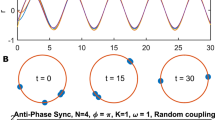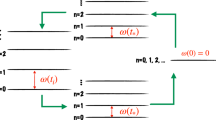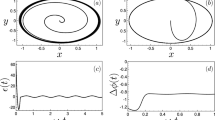Abstract
ONE of the most remarkable developments in quantum mechanics in recent years has been the discovery that when a system is moved adiabatically around a closed loop in parameter space there occurs, besides the familiar dynamical phase shift, an additional phase shift (sometimes referred to as 'Berry's phase) that is purely geometric in nature1–3. The dynamical phase shift, which results from the variation of the period of the oscillatory system with the change in parameters, is relatively easily understood and is proportional to the time over which the parameter change occurs. The geometric phase shift, on the other hand, is less intuitive and depends on the curvature of the surface in parameter space bounded by the closed path, but is independent of the time taken to traverse the circuit. Here we present evidence for time-independent geometric phase shifts in numerical solutions for a model of an oscillating chemical reaction. The conditions for the occurrence of such shifts seem to be sufficiently general that geometric phase effects should be experimentally observable in essentially all chemical oscillators as well as in biological networks such as the brain and the central nervous system, where phase control is of vital importance4.
This is a preview of subscription content, access via your institution
Access options
Subscribe to this journal
Receive 51 print issues and online access
$199.00 per year
only $3.90 per issue
Buy this article
- Purchase on Springer Link
- Instant access to full article PDF
Prices may be subject to local taxes which are calculated during checkout
Similar content being viewed by others
References
Berry, M. V. Proc. R. Soc. Lond. A 392, 45–57 (1984).
Shapere, A. & Wilczek, F. (eds) Geometric Phases in Physics (World Scientific, Singapore, 1989).
Berry, M. V. Sci. Am. 259(6), 46–52 (1988).
Basar, E. & Bullock, T. (eds) Induced Rhythms in the Brain (Birkhauser, Boston, in the press).
Hannay, J. H. J. Phys. A 18, 221–230 (1985).
Berry, M. V. J. Phys. A 18, 15–27 (1985).
Berry, M. V. Proc. R. Soc. Lond. A 414, 31–46 (1987).
Simon, R., Kimble, H. J. & Sudarshan, E. C. G. Phys. Rev. Lett. 61, 19–22 (1988).
Maddox, J. Nature 334, 99 (1988).
Suter, D., Pines, A. & Mueller, K. T. Phys. Rev. Lett. 60, 1218–1220 (1988).
Zee, A. Phys. Rev. A 38, 1–6 (1988).
Shapere, A. & Wilczek, F. J. Fluid Mech. 198, 557–585 (1989).
Kepler, T. B. & Kagan, M. L. Phys. Rev. Lett. (in the press).
Field, R. J. & Burger, M. (eds) Oscillations and Traveling Waves in Chemical Systems (Wiley, New York, 1985).
De Kepper, P., Epstein, I. R., Kustin, K., & Orbán, M. J. phys. Chem. 86, 170–171 (1982).
Lengyel, I., Rabai, G. & Epstein, I. R. J. Am. chem. Soc. 112, 9104–9110 (1990).
Prigogine, I. & Lefever, R. J. chem. Phys. 48, 1695–1700 (1968).
Epstein, I. R. J. chem. Educ. 66, 191–195 (1989).
Author information
Authors and Affiliations
Rights and permissions
About this article
Cite this article
Kagan, M., Kepler, T. & Epstein, I. Geometric phase shifts in chemical oscillators. Nature 349, 506–508 (1991). https://doi.org/10.1038/349506a0
Received:
Accepted:
Issue Date:
DOI: https://doi.org/10.1038/349506a0
Comments
By submitting a comment you agree to abide by our Terms and Community Guidelines. If you find something abusive or that does not comply with our terms or guidelines please flag it as inappropriate.



